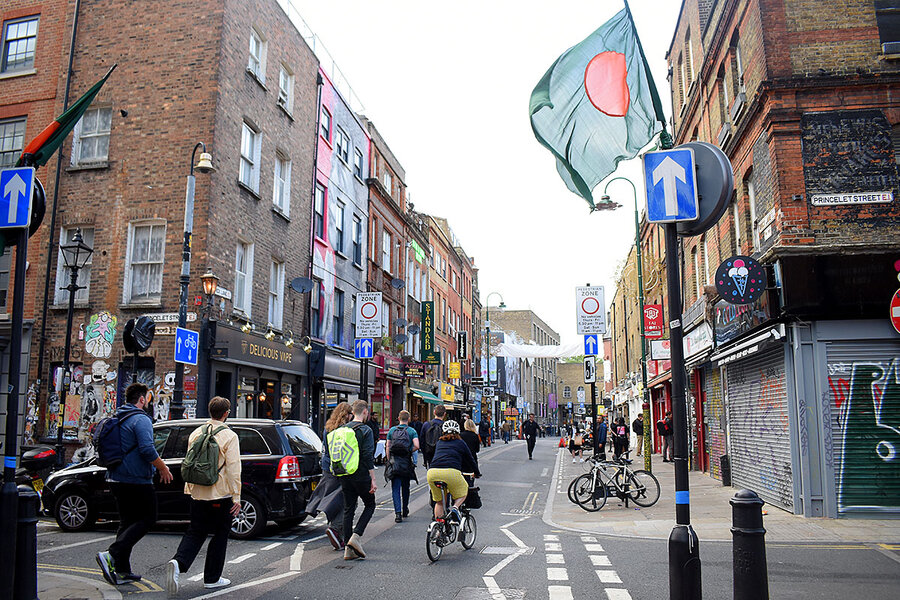Britain’s Bangladeshis aim to save Brick Lane – and their immigrant story
Loading...
| LONDON
London’s Brick Lane, known colloquially as Banglatown since curry houses here boomed in the 1990s and drew visitors from around the globe, embodies Britain’s immigration story. Bangladeshis fleeing civil war at home settled into the area’s red-brick housing, following the path of earlier immigrants. Life was difficult and racism was a constant challenge, but they created a home that many remember lovingly. One elected councilor recalls his childhood in Brick Lane: “There was genuine love here in the East End of London,” he says. “It was the best time of my life.”
Now Brick Lane finds itself under threat again, this time from gentrification. But the community is leaning in on a history of adaptation and coexistence with protest, art, and public gatherings. “There’s something in the air, a weirdly poetic air,” says Sabina Begum, a British-born Bangladeshi whose father grew up in the area during the 1970s. “I’m transported back to Bangladesh. … Small fragments of Bangladesh live there. It’s completely different to other places.”
Why We Wrote This
A story focused onLondon’s Brick Lane embodies immigrant resilience. Now the Bangladeshi community that has called “Banglatown” home for decades fights a new foe in the form of gentrification and “hipsterfication.”
Abdal Ullah still remembers the waft of chapati and chai served from the cafes beneath his family apartment on Brick Lane, the East London community settled by Bangladeshi families in the late 1970s and ’80s.
He arrived from his native Bangladesh at age 4, part of a migration that ultimately turned this community of graffitied walls, rumbling freight trains, and old, red-brick housing into the largest Bangladeshi population outside Bengal.
Life was not easy. The newcomers faced racism, overcrowding, and tenuous work conditions in nearby garment factories and warehouses, and many Britons wanted the immigrants gone. But for Mr. Ullah, who is now an elected councilor in London, Brick Lane imprinted his childhood memories with camaraderie and lessons of communal survival. “There was genuine love here in the East End of London,” he says. “It was the best time of my life.”
Why We Wrote This
A story focused onLondon’s Brick Lane embodies immigrant resilience. Now the Bangladeshi community that has called “Banglatown” home for decades fights a new foe in the form of gentrification and “hipsterfication.”
Now, as Brick Lane finds itself under threat – this time from rising rents, gentrification, and the economic fallout from the pandemic – the community is mobilizing again. Housing rights activists recently lost an attempt to stop the development of a shopping mall in a local historic building, something activists say is the bell signaling the end of 400 years of migrant history in favor of corporate space. But to preserve their unique community, they are leaning in on a history of adaptation and coexistence with protest, art, and public gatherings.
“There’s something in the air, a weirdly poetic air,” says Sabina Begum, a British-born Bangladeshi whose father grew up in the area during the 1970s. “I’m transported back to Bangladesh. … Small fragments of Bangladesh live there. It’s completely different to other places.”
“A haven for the downtrodden”
Brick Lane, known colloquially as “Banglatown” since curry houses here boomed in the 1990s and drew visitors from around the globe, embodies the immigration story in the United Kingdom. In the 1600s, the area was home to persecuted French Huguenots who settled here because it was close to the old Roman walls of London.
By the 18th and 19th centuries, Jewish and Irish migrants had moved into the densely populated area, filling up ramshackle slums. The Nazis targeted the area’s factories and docks in a heavy bombing campaign during World War II, and by the 1960s, most of the Jewish community had dispersed to London’s suburbs. That’s when Bangladeshis began to arrive, with the two groups coexisting for a time.
“When Jewish communities escaped the pogroms to settle in the East End, the Irish communities did the same. They too were escaping state violence,” says Fatima Rajina, an academic in British Bangladeshi history and member of the campaign to save historic Brick Lane. “The East End has always been a hub to find safety and became a haven for the downtrodden, the unwanted in society.”
Nowhere is this coexistence exemplified better than one particular building: Brick Lane Mosque, which has stood for over 300 years. It is the only building in the U.K. to have housed all three Abrahamic faiths. A modern take on a minaret juts out from a stone building that was once a Jewish synagogue, and, before that, a French church.
“When you stand by the mosque, at the top there is a sign in Latin which says ‘we are shadows,’” says Dr. Rajina. “It means people come and go; they establish themselves, and through their own choice – not through coercion – move on.”
That doesn’t mean Bangladeshis haven’t been coerced. Since their arrival in the 1960s, and then upon civil war after the breakup of Pakistan, they have been targeted by the British far-right, sometimes in rhetoric and sometimes violently. In 1978, Altab Ali, a young textile worker walking home from work, was stabbed to death. In 1999, a neo-Nazi militant detonated a nail bomb targeting London’s Black and Bangladeshi communities, injuring Muslim worshippers gathering for prayers.
Through these attacks the Bangladeshi community forged a culture of political mobilization, often alongside other targeted minorities fighting systematic racism in British society. “Bangladeshis are a group of people that have always been the underdogs but always resisted through creativity, protest, and activism,” says Aminul Hoque, lecturer and presenter of the BBC documentary “A Very British History: British Bangladeshis.”
Now that activism is being reactivated, this time in the fight against gentrification. London’s British Bangladeshi population predominantly live in the eastern part of London – a community that is among the most deprived in the U.K. in terms of jobs and education. Yet it sits right next to the richest area, the City of London financial district, which has put pressure on rents for residents and local businesses. In 15 years, the number of curry shops in Banglatown has declined by 62%.
Today, 24% of British Bangladeshis live in overcrowded and multigenerational households, by far the highest percentage of any ethnic group. That has put them at higher risk during the pandemic, which has also dealt a blow to local business.
The latest loss to Brick Lane is the former Truman Brewery, a site of historical importance. Production ceased there some 25 years ago and the building is now used by 300 mainly small businesses. It has an estimated present-day value of £700 million (about $936 million). Activists from Nijjor Manush, a grassroots campaign group that in Bengali means “our people,” say the development project, which faces a partial demolishment and the creation of a five-story block with retail space, will further erode the area’s heritage.
Throughout the spring and summer, protesters unfurled banners reading “Stop the Truman Brewery Shopping Mall.” In September, at a memorial park that sits where Mr. Ali was killed in 1978, activists organized a protest, holding aloft an empty coffin and silently marching through Brick Lane to the Truman Brewery.
“Brick Lane has social and cultural capital. When people come here, they want to come to East London because it’s historic and urban,” says Saif Osmani, a visual artist and activist with Nijjor Manush who was at the protest against the Truman project. “All of that is under threat.”
“Framing Banglatown”
Mr. Osmani expresses his fight for his community and its tenacity through his work in the “white dominated world” of visual arts, architecture, and housing. This summer, in an exhibition called “Framing Banglatown,” he organized a collection of prints that “capture the nexus” between the Bangladeshi community and the impact of “hipster culture” creeping in.
“Sometimes you have to vouch for your communities in your job. For me, that’s in architecture,” he says. Both his mother and father worked in health and education for the local area, teaching him the virtues of being an “advocate” for his community through work. “I’ve never felt indifferent to that.”
But divisions have also surfaced in the community about the best way forward. For Mr. Ullah, it’s about preserving Bangladeshi national identity. Amid pressures of gentrification, this year marks 50 years since the creation of Bangladesh, and he wants local authorities to commission new artwork, publications, and an awards ceremony for young people in an effort to revitalize Banglatown.
Others believe the way forward lies in adapting with the city – and holding onto the coexistence that undergirds the Bangladeshi experience in Britain.
Mabrur Ahmed, a third-generation Bangladeshi born in Birmingham, just opened a cafe called Root25 in Bow, traditionally the heart of white-working-class London and in walking distance from Brick Lane. The cafe helps to fund his human rights organization, Restless Beings. On a recent afternoon imams gossip while drinking tea. Young women gather for a book reading, while a same-sex couple drink chai, cocooned on a leather sofa.
“Adaptation is key; it is deep within us,” says Mr. Ahmed. “To balance your heritage, be true to your roots, and take the best parts of being British is the way we forge our own spaces that cater to both specific groups, and to everyone,” he says.
“We battle change by adjusting, but not excluding,” he adds. “Activism is in our blood. So too, the sweetness of tea, food, and community spirit.”










